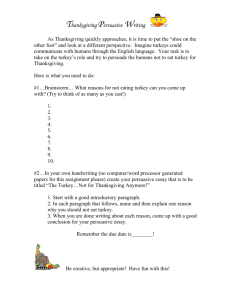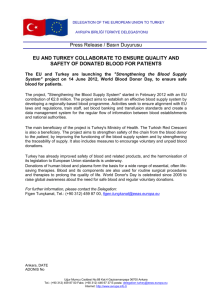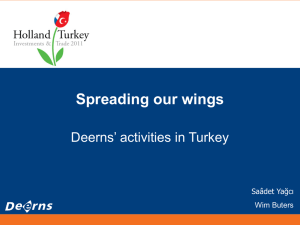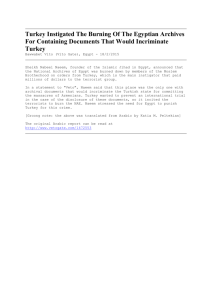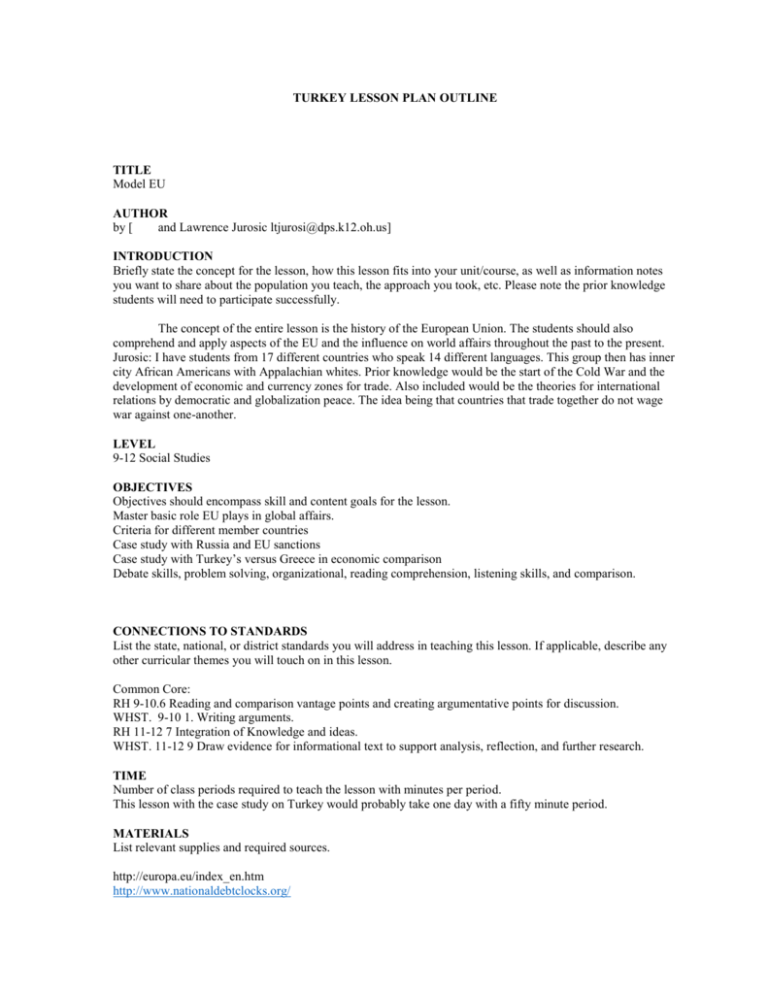
TURKEY LESSON PLAN OUTLINE
TITLE
Model EU
AUTHOR
by [
and Lawrence Jurosic ltjurosi@dps.k12.oh.us]
INTRODUCTION
Briefly state the concept for the lesson, how this lesson fits into your unit/course, as well as information notes
you want to share about the population you teach, the approach you took, etc. Please note the prior knowledge
students will need to participate successfully.
The concept of the entire lesson is the history of the European Union. The students should also
comprehend and apply aspects of the EU and the influence on world affairs throughout the past to the present.
Jurosic: I have students from 17 different countries who speak 14 different languages. This group then has inner
city African Americans with Appalachian whites. Prior knowledge would be the start of the Cold War and the
development of economic and currency zones for trade. Also included would be the theories for international
relations by democratic and globalization peace. The idea being that countries that trade together do not wage
war against one-another.
LEVEL
9-12 Social Studies
OBJECTIVES
Objectives should encompass skill and content goals for the lesson.
Master basic role EU plays in global affairs.
Criteria for different member countries
Case study with Russia and EU sanctions
Case study with Turkey’s versus Greece in economic comparison
Debate skills, problem solving, organizational, reading comprehension, listening skills, and comparison.
CONNECTIONS TO STANDARDS
List the state, national, or district standards you will address in teaching this lesson. If applicable, describe any
other curricular themes you will touch on in this lesson.
Common Core:
RH 9-10.6 Reading and comparison vantage points and creating argumentative points for discussion.
WHST. 9-10 1. Writing arguments.
RH 11-12 7 Integration of Knowledge and ideas.
WHST. 11-12 9 Draw evidence for informational text to support analysis, reflection, and further research.
TIME
Number of class periods required to teach the lesson with minutes per period.
This lesson with the case study on Turkey would probably take one day with a fifty minute period.
MATERIALS
List relevant supplies and required sources.
http://europa.eu/index_en.htm
http://www.nationaldebtclocks.org/
http://query.nytimes.com/search/sitesearch/?action=click&contentCollection&region=TopBar&WT.nav=search
Widget&module=SearchSubmit&pgtype=Homepage#/turkey and Eu
link to common core accountable talk format.
http://www.google.com/url?sa=t&rct=j&q=&esrc=s&source=web&cd=6&ved=0CCsQFjAF&url=http%3A%2
F%2Fcurriculum.dpsk12.org%2Flang_literacy_cultural%2Fliteracy%2Felem_lit%2Fcurric_instruc_assess%2Fi
nterdisc_units%2FAccountableTalkFeaturesandLanguageStems.pdf&ei=V7TqU_WhPIOjyATQtIKQBQ&usg=
AFQjCNETbSg6nx6SxYxf1FjbRhwtMb_ATA
BACKGROUND ESSAY (YOU CAN COMBINE THIS INTO THE INTRODUCTION)
Turkey is being excluded from the European Union and a trade deal with the United States of America. Turkey
is dependent upon Russia for most of its petroleum needs. This means that despite being aligned with the United
States, through NATO, they(Turkey) are forced to be dependent upon Russia. This also means that Turkey is
being left out of Europe again which may push them further towards the Russian camp. This is placing our ally
in a tough spot. When the Cold War ended many countries became Economic miracles behind the iron curtain.
Turkey stood by the United States and their development is still not that of newly liberated Eastern European
countries. This should be addressed if we are going to continue to call Turkey our ally. It should also be noted
that former communist block countries are being considered for the EU and not Turkey. Students specifically in
my class do not want to be excluded. The opening activity is to have them remember an exclusion event and
what it is like to be held out for no reason. I am interested to see their remedies and push them to see if they can
do more.
PROCEDURES
Number the steps in your procedure and take care to explain in detail how you will execute this lesson. If your
procedures include a discussion, please include sample questions and answers (if appropriate).
1.
2.
3.
4.
5.
6.
Have students draw straws and complete bell ringer about leaving people out and tension that would
cause in the room or any other circumstance they can think of.
Break students into groups with the short straws being Turkey. Each groups is going to be responsible
for gathering data and presenting a case. One group will be Greece, another group will be Germany,
and finally one France. The groups will have to make a case for or against Turkey’s inclusion into the
EU. Turkey obviously will. The rest of the groups have to offer reasons. Each person in the group is
going to be responsible for researching one of the sources listed above and using the facts to build their
arguments.
Finally, students may create graphs and data to present their cases.
Using the accountable talk formula students should then debate
Close debate and then vote.
Then problem solve as a class Turkey’s options for gaining entry into the Euro Zone.
ASSESSMENT
Problem solving; Homework, will be weighting possible options for Turkey.
EXTENSION IDEA
Have interested students write Congress members and Senate members.
SOURCES
Harman, Chris. A People's History of the World. London: Bookmarks, 1999.
Held, David. A Globalizing World?: Culture, Economics, Politics. London:
Routledge in Association with the Open University, 2000.
Hollis, Martin, and Steve Smith. Explaining and Understanding International
Relations. Oxford: Clarendon Press ;, 1990.
Briggs, Asa, and Patricia Calivn. Modern Europe: 1789-present. Revised/Expanded
ed. London: Pearson Longman, 2003.
HANDOUTS
Cagaptay, Soner. "The E.U. Needs Turkey." The New York Times. December 20,
2013. Accessed August 13, 2014.
Adapted from Institute for Learning, 2003
Accountable Language Stems
Agreement
agree with _____ because _____.”
like what _____ said because _____.”
“I agree with _____; but on the other hand, _____.”
Disagreement
disagree with _____ because _____.”
“I’m not sure I agree with what _____ said because _____.”
“I can see that _____; however, I disagree with (or can’t see) _____.”
Clarifications
you please repeat that for me?”
Paraphrase what you heard and ask, “Could you explain a bit more, please?”
“I’m not sure I understood you when you said _____. Could you say more about that?”
your evidence?”
does that support our work/mission at _____?”
Confirmation
think _____.”
believe _____.”
Confusion
don’t understand _____.”
am confused about _____.”
Extension
was thinking about what _____ said, and I was wondering what if _____.”
“This makes me think _____.”
want to know more about _____.”
“Now I am wondering _____.”
you tell me more about _____?”
Review
want to go back to what _____ said.”
Adapted from Institute for Learning, 2003
Features of Accountable Talk Accountability to the Learning Community
a. Careful listening to each other
b. Using and building on each other’s ideas
c. Paraphrasing and seeking clarification
d. Respectful disagreement e. Using sentence stems
Accountability to Accurate Knowledge
f. Being as specific and accurate as possible
g. Resisting the urge to say just “anything that comes to mind.”
h. Getting the facts straight
i. Challenging questions that demand evidence for claims
Accountability to Rigorous Thinking
j. Building arguments
k. Linking claims and evidence in logical ways
l. Working to make statements clear
m. Checking the quality of claims and arguments


